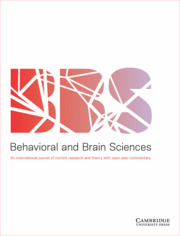Article contents
Resource-rational analysis: Understanding human cognition as the optimal use of limited computational resources
Published online by Cambridge University Press: 04 February 2019
Abstract
Modeling human cognition is challenging because there are infinitely many mechanisms that can generate any given observation. Some researchers address this by constraining the hypothesis space through assumptions about what the human mind can and cannot do, while others constrain it through principles of rationality and adaptation. Recent work in economics, psychology, neuroscience, and linguistics has begun to integrate both approaches by augmenting rational models with cognitive constraints, incorporating rational principles into cognitive architectures, and applying optimality principles to understanding neural representations. We identify the rational use of limited resources as a unifying principle underlying these diverse approaches, expressing it in a new cognitive modeling paradigm called resource-rational analysis. The integration of rational principles with realistic cognitive constraints makes resource-rational analysis a promising framework for reverse-engineering cognitive mechanisms and representations. It has already shed new light on the debate about human rationality and can be leveraged to revisit classic questions of cognitive psychology within a principled computational framework. We demonstrate that resource-rational models can reconcile the mind's most impressive cognitive skills with people's ostensive irrationality. Resource-rational analysis also provides a new way to connect psychological theory more deeply with artificial intelligence, economics, neuroscience, and linguistics.
Keywords
Information
- Type
- Target Article
- Information
- Copyright
- Copyright © Cambridge University Press 2019
References
- 346
- Cited by



Target article
Resource-rational analysis: Understanding human cognition as the optimal use of limited computational resources
Related commentaries (25)
Another claim for cognitive history
Beginning with biology: “Aspects of cognition” exist in the service of the brain's overall function as a resource-regulator
Can resources save rationality? “Anti-Bayesian” updating in cognition and perception
Cognitively bounded rational analyses and the crucial role of theories of subjective utility
Computational limits don't fully explain human cognitive limitations
Generalization of the resource-rationality principle to neural control of goal-directed movements
Heuristics and the naturalistic fallacy
Holistic resource-rational analysis
Multiple conceptions of resource rationality
Opportunities and challenges integrating resource-rational analysis with developmental perspectives
Opportunities for emotion and mental health research in the resource-rationality framework
Optimal, resource-rational or sub-optimal? Insights from cognitive development
Representing utility and deploying the body
Resource-rational analysis versus resource-rational humans
Resource-rationality and dynamic coupling of brains and social environments
Resource-rationality as a normative standard of human rationality
Resource-rationality beyond individual minds: the case of interactive language use
Sampling as a resource-rational constraint
The biology of emotion is missing
The evolutionary foundations of resource-rational analysis
The importance of constraints on constraints
Towards a quantum-like cognitive architecture for decision-making
Uncovering cognitive constraints is the bottleneck in resource-rational analysis
What are the appropriate axioms of rationality for reasoning under uncertainty with resource-constrained systems?
What is the purpose of cognition?
Author response
Advancing rational analysis to the algorithmic level